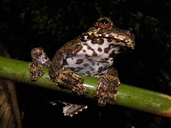|
Ecnomiohyla miliaria (Cope, 1886)
Cope's Brown Treefrog | family: Hylidae subfamily: Hylinae genus: Ecnomiohyla |
 © 2024 Marcos Ponce (1 of 7) |
|
|
|
Description The head is flat on top and rounded in dorsal outline, and the snout appears truncate in both dorsal and lateral outline. The tympanum is about half the size of the eye, and above it a bony ridge followed by a dermal fold extends posteriorly to just above the arm's insertion. The canthus is rounded and the internarial area is depressed. Arms are short and robust, and the immense hand bears large discs. The legs are long and moderately robust, and the feet also bear large discs. Recorded snout-vent length measurements ranged from 57.2 to 106.0 mm for male adults, and 69.7 mm for the single collected female (all above descriptions from Duellman 1970). The dorsal coloration is mottled with dark brown, metallic green, and orange-tan, while ventral surfaces range from pink-tan to light-brown, except for the anal region which is creamy white. The chin has white tubercles and dark brown spots, the tympanum, webbing, and discs are dark brown, and the iris is bronze with reddish-brown reticulations (all color descriptions from Duellman 1970). No call has been attributed to this species, although a "loud growl-like" sound has been noted (Duellman 1970). Distribution and Habitat Country distribution from AmphibiaWeb's database: Colombia, Costa Rica, Honduras, Nicaragua, Panama
Life History, Abundance, Activity, and Special Behaviors There is not enough data available to estimate species abundance. Trends and Threats Comments A Spanish-language species account can be found at the website of Instituto Nacional de Biodiversidad (INBio).
References
Duellman, W.E. (1970). The Hylid Frogs of Middle America. Monograph of the Museum of Natural History, University of Kansas. Holdridge, L. R. (1967). Life Zone Ecology. Tropical Science Center, San Jose, Costa Rica. Savage, J. M., and Heyer, W. R. (1968). ''The tree-frogs (Family Hylidae) of Costa Rica: diagnosis and distribution.'' Revista de Biologia Tropical, 16(1), 1-127. Originally submitted by: Sean Schoville (first posted 2000-02-27) Description by: Michelle S. Koo (updated 2021-03-18)
Comments by: Michelle S. Koo (updated 2021-03-18)
Edited by: Meredith J. Mahoney (2021-03-18) Species Account Citation: AmphibiaWeb 2021 Ecnomiohyla miliaria: Cope's Brown Treefrog <https://amphibiaweb.org/species/871> University of California, Berkeley, CA, USA. Accessed Nov 12, 2024.
Feedback or comments about this page.
Citation: AmphibiaWeb. 2024. <https://amphibiaweb.org> University of California, Berkeley, CA, USA. Accessed 12 Nov 2024. AmphibiaWeb's policy on data use. |




 Map of Life
Map of Life